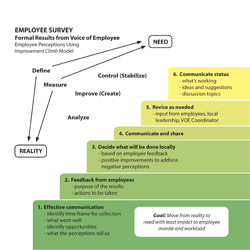
The ability to recruit, develop, motivate and retain good performers is key to sustaining a competitive advantage for businesses in the long term. In these tough economic times, it may be a challenge to build a high-caliber workforce. The Human Performance Improvement (HPI) process provides employers with a tool that links business strategy and goals with an employee’s ability to achieve them.
The steps in the HPI process and the interrelationships among them are shown in the attached model.
The HPI process incorporates business results with improving human performance. While the model may appear somewhat sequential, only certain steps in the model actually happen in a specific order. Change management is an umbrella over the entire process, to demonstrate how solutions typically require some sort of organizational change.
The HPI process initiates when a performance gap exists. During the first steps of the process, business goals are identified, and the desired level of performance is compared with the actual level of performance. Using a systematic approach, root cause analysis begins. In most instances, the HPI process is linear from business analysis through intervention implementation.
HPI Process Steps
- Business analysis. This is the discovery phase where business goals from key decision makers ensure all subsequent activities are aligned to desirable business results.
- Performance analysis. In this step, desired levels of performance are directly linked to business goals.
- Data collection. Current (actual) levels of performance are collected in this step. The difference between the desired and the actual performance reveals the performance gap.
- Cause analysis. After collecting the data, move on to ascertaining reasons for the performance gap (between desired and actual performance) and probe beneath surface symptoms to discover the underlying root cause.
- Intervention selection. Once the root cause has been determined, select the solution that best matches the issue with the root cause. An intervention is any combination of tools and techniques that clearly and directly relate to the performance gap.
- Intervention implementation. Next, work to implement the solution that best removes or reduces the issue. This may include working with specialized implementation teams or could be a one-on-one solution.
- Evaluation. After implementation, it’s necessary to measure the updated actual performance and compare that to the desired level of performance. If the gap still exists, it may be necessary to determine if an additional intervention is necessary to close the gap. If evaluation reveals or shows that the gap has been eliminated, that should be reported with business results.
Throughout the process, it is necessary to design, develop and implement organizational changes, which is why change management is an overarching component of the HPI process. Change must start with the individual, permeate through the team, and finally encompass the entire organization.
Conclusion
Training is the answer to many performance issues, but it’s not an absolute answer when the HPI process is utilized. Human resources and organization development professionals can no longer safely assume training is the “magic cure” for all performance ills. Today's organizations focus on performance, so the shift to human performance improvement has a tremendous impact on how employees perform their job duties as well as how they interact with co-workers, customers and managers. iBi
Susan Warren, MBA, is retired from the United States Postal Service and owns SKW Consulting. She is the immediate past president of the Heart of Illinois chapter of ASTD. Sarah Jeffcoat is an instructional designer with CEFCU and president of the Heart of Illinois chapter of ASTD.

